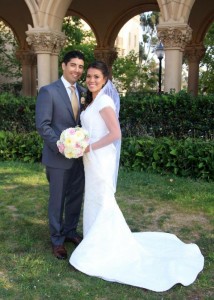
Andrew and Gloria Luna’s love story began at BYU, but not in the traditional boy-meets-girl-in-class scenario.
The Lunas matched through Tinder last year and messaged each other until they met in person at a BYU salsa club event in January. Eight months later, they were married in Gilbert, Arizona.
Stories like the Lunas’ aren’t as rare anymore because more BYU couples are meeting and matching through Tinder.
Tinder, one of the most popular smartphone dating apps, allows people to see pictures of singles in their area and either swipe right to show interest or swipe left to go on to the next person. If both parties swipe right, each is notified through the app, and the two can then communicate with each other.
Tinder’s blog shared numbers of worldwide usage, showing 196 countries that use Tinder, with 1.6 billion swipes per day, 26 million matches per day and a total of nine billion matches overall.
On Aug. 26, 2015, GoTinder.com released the stats for the “Most Swiped-Right Schools” in the United States. BYU ranked second in the nation, just behind Georgetown University for the most guys at the university to swipe right.
Tinder can create a type of numbers game between seeing how many people swipe right on someone’s profile and how many matches someone has, according to BYU professor and student psychologist Russell Bailey.
“I think that some people think of marriage as a numbers game, as if they just need to meet as many people as possible and that will increase their odds of finding the right one,” Bailey said.
Bailey said Tinder studies have shown that people who use the app might have a more difficult time dating than those who do not use the app.
“Some of the popular research on the topic would suggest the ‘paradox of choice.’ Having thousands of options via online networks makes dating choices harder instead of easier,” Bailey said.
He said the size of the network means each person has many options and that people are always looking for better options than the ones they are presented with in person.
“So a person keeps looking without taking time to make a small-level commitment, to really, really get to know a person,” Bailey said.
BYU family studies professor Brian Willoughby said people at BYU tend to look for dating opportunities that lead to commitment and hopefully marriage.
“I think (Tinder) can be a great tool for initial contacting and casting a wide net,” Willoughby said. “Unfortunately, in most parts of the country, Tinder has become highly used for casual sexual encounters.”
The reputation of Tinder on a national level does not match the values of an average BYU student, which is often why students don’t use Tinder in the first place. The reasoning for students at BYU to have Tinder may be a lot different from the desire of students attending other schools, according to Andrew Luna.

Luna said he wanted more from Tinder than he was originally getting: he wanted to meet girls, go on dates and eventually find someone to marry. He said at BYU, where one in four students are married, there is a high priority set on the importance of marriage within the student body.
Over the last 20 years, 23 percent or more of BYU’s population on campus has been married. Though above 72 percent of people are single at BYU, there still seems to be pressure for many students to marry while attending the university, according to Bailey.
“The pressure to marry is certainly part of the BYU culture,” Bailey said. “Dating and relationships tend to get emphasized around here.”
500 BYU students took a survey in November 2015 about the use of social media and other dating avenues on BYU campus.
Seventeen percent of the 500 students surveyed said they had or have had a Tinder account, while only three percent of that 17 percent said they found a recent date from Tinder.
Bailey said social media has changed the way many students interact. Some students would rather text someone than call to set up a date, while others would prefer to send a Facebook message or swipe right.
Bailey invited those students who don’t want to be involved in the dating game and who find dating to be stressful to visit the Counseling and Psychological Services office at BYU. He said dating at BYU seems too focused on the need to decide whether or not a person is marriage material on the first date.
“Give it time,” Bailey said. “You really need more information about a person to make decisions about relationships. Focus on learning about a person and letting them get to know you for a while.”




